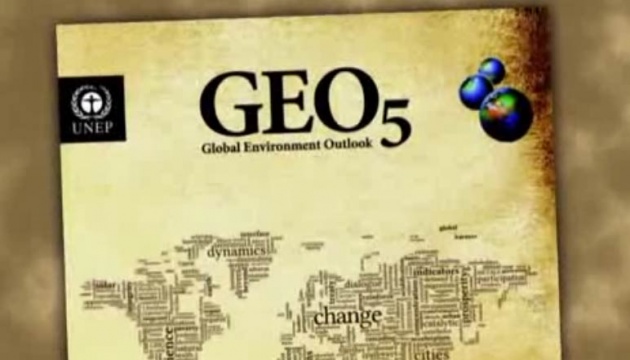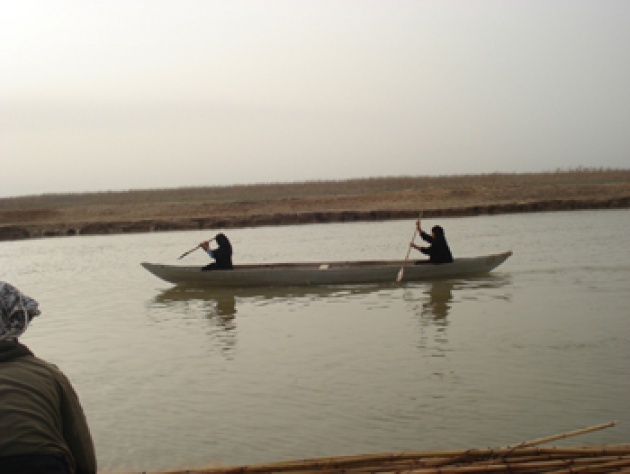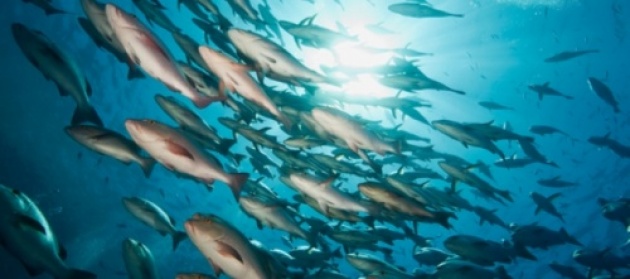
Only 4 of the 90 most important environmental goals/agreements are being fulfilled according to the Global Environmental Outlook (GEO-5), launched ahead of the UN Conference on Sustainable Development (Rio+20) in Brazil for June 20-22, 2012. UNEP, the UN’s environmental agency warned that the world “continues to speed down” an unsustainable path in spite of hundreds of internationally agreed goals to protect the planet, and stressed that drastic actions and big-scale measures are needed to reverse this pattern. “If current trends continue, if current patterns of production and consumption of natural resources prevail and cannot be reversed and ‘decoupled,’ then governments will preside over unprecedented levels of damage and degradation,” according to UNEP Executive Director Achim Steiner.(Find below Mr. Steiner’s full statement and more detailed summary plus further links of the analysis). Read our Blog for Film: “World Environment Day Sets Hopes for Rio+20".

Mixed Record at Best:
The 4 goals being achieved entail eliminating the production and use of substances that deplete the ozone layer, the removal of lead from fuel, increasing access to improved water supplies, and boosting research to reduce pollution of the marine environment
According to the assessment, while some progress was shown in 40 goals, including efforts to reduce deforestation, little or no progress was detected for 24 of them, including climate change, desertification and drought. In addition, there were eight goals which showed no progress and instead further deterioration, such as the state of the world’s coral reefs. See Film for Blog Report - “Rio+20 – Your Future?"

Scientifically: “Little Room for Doubt”
GEO 5, which was produced over a period of three years and with the collaboration of over 600 environment experts, also highlights that when international treaties and agreements have tackled goals with specific, measurable targets they have demonstrated considerable success. Mr. Steiner employed the GEO-5 to stress the scientific basis and need for action:“GEO-5 reminds world leaders and nations meeting at Rio+20 why a decisive and defining transition towards a low-carbon, resource-efficient, job-generating green economy is urgently needed. The scientific evidence, built over decades, is overwhelming and leaves little room for doubt.”
Ambassador Muhamed Sacirbey - FOLOW mo @MuhamedSacirbey
Facebook-Become a Fan at “Diplomatically Incorrect”
Twitter – Follow us @DiplomaticallyX
See more at our Popular Video Blogs & Current News Event Articles – Ecology-Diplomat Channel

Rio, 6 June 2012 - The world continues to speed down an unsustainable path despite over 500 internationally agreed goals and objectives to support the sustainable management of the environment and improve human wellbeing, according to a new and wide-ranging assessment coordinated by the United Nations Environment Programme (UNEP).
The fifth edition of the Global Environmental Outlook (GEO-5), launched on the eve of the Rio+20 Summit, assessed 90 of the most-important environmental goals and objectives and found that significant progress had only been made in four.
Further Resources
- GEO-5 Full Report
- Regional Summary for Africa
- Regional Summary for Asia Pacific
- Regional Summary for Europe
- Regional Summary for Latin America and the Caribbean
- Regional Summary for North America
- Regional Summary for West Asia
- GEO-5 Meeting Progress Report
- GEO-5 Press Release in Arabic
- GEO-5 Press Release in Chinese
- GEO-5 Press Release in French
- GEO-5 Press Release in Portuguese
- GEO-5 Press Release in Russian
- GEO-5 Press Release in Spanish
- Full GEO-5 Media Resources in all UN Languages
- GEO-5 video
These are eliminating the production and use of substances that deplete the ozone layer, removal of lead from fuel, increasing access to improved water supplies and boosting research to reduce pollution of the marine environment - for a full list of goals and status of implementation, visit: www.unep.org/geo/pdfs/geo5/Progress_towards_goals.pdf .
Some progress was shown in 40 goals, including the expansion of protected areas such as National Parks and efforts to reduce deforestation.
Little or no progress was detected for 24 - including climate change, fish stocks, and desertification and drought.
Further deterioration was posted for eight goals including the state of the world's coral reefs while no assessment was made of 14 other goals due to a lack of data.
The report cautions that if humanity does not urgently change its ways, several critical thresholds may be exceeded, beyond which abrupt and generally irreversible changes to the life-support functions of the planet could occur.
"If current trends continue, if current patterns of production and consumption of natural resources prevail and cannot be reversed and 'decoupled', then governments will preside over unprecedented levels of damage and degradation," said UN Under-Secretary General and UNEP Executive Director Achim Steiner.
But it's not all bad news. The report says meeting an ambitious set of sustainability targets by the middle of the century is possible if current policies and strategies are changed and strengthened, and gives many examples of successful policy initiatives, including public investment, green accounting, sustainable trade, the establishment of new markets, technological innovation and capacity building.
GEO-5 also points out that where international treaties and agreements have tackled goals with specific, measurable targets-such as the bans on ozone-depleting substances and lead in petrol-they have demonstrated considerable success. For this reason, GEO-5 calls for more specific targets, with quantifiable results, across a broader range of environmental challenges.
"GEO-5 reminds world leaders and nations meeting at Rio+20 why a decisive and defining transition towards a low-carbon, resource-efficient, job-generating Green Economy is urgently needed," said Mr. Steiner. "The scientific evidence, built over decades, is overwhelming and leaves little room for doubt."
"The moment has come to put away the paralysis of indecision, acknowledge the facts and face up to the common humanity that unites all peoples," he added. "Rio+20 is a moment to turn sustainable development from aspiration and patchy implementation into a genuine path to progress and prosperity for this and the next generations to come."
The report also calls for a greater focus on policies that target the drivers of environmental change - such as population growth and urbanization, unsustainable consumption patterns, fossil fuel-based energy consumption and transport, and globalization.
In particular, globalization has made it possible for trends in drivers to generate intense pressures in concentrated parts of the world very quickly, as in the case of increased demand for biofuels leading to land clearance and conversion.
Although reducing the drivers of environmental change directly may appear politically difficult, it is possible to accomplish significant indirect benefits by targeting more expedient objectives, such as international goals on human well-being, the report says.
Data Gaps and Measuring Progress
Keeping track of the state of the global environment relies heavily on data and statistics collected by national governments.
Data gaps in a number of key issues (chemicals/waste and freshwater pollution being two glaring examples) make it very difficult to measure progress towards goals in these areas.
In the area of chemicals and waste, for example, keeping up with the ever-growing number of chemicals used in commerce and the lack of sufficient information on contaminated sites challenges many governments and hampers response efforts.
At the same time, it is impossible to assess global trends in freshwater pollution because of inadequate data.
GEO-5 notes that linking environmental data with national statistics can place the environment at the heart of national priorities and policy making.
State of the Environment
Scientific evidence shows that Earth systems are being pushed towards their biophysical limits, with evidence that these limits are close and have in some cases been exceeded.
Atmosphere
Of the nine internationally agreed atmospheric goals reviewed, significant progress has been made in eliminating substances that deplete the ozone layer and the phase-out of lead in gasoline, but there has been little or no progress on serious issues such as indoor air pollution and climate change.
Ozone
The world has nearly eliminated the production and use of ozone depleting substances, under the Montreal Protocol.
- It is estimated that implementation of the Protocol will result, in the United States alone, in 22 million fewer cases of cataracts in people born between 1985 and 2100, and 6.3 million fewer skin cancer deaths by mid-century.
- While further expansion of the Antarctic 'ozone hole' has been halted, full recovery is not expected until mid-century or later.
- One group of ozone replacement chemicals - hydroflurocarbons(HFCs) - still needs to be phased out due to many having a high global warming potential.
Lead in Gasoline
Nearly all countries have phased out lead in gasoline. Reduced health risks due to the phase-out have estimated economic benefits of US $2.45 trillion a year, or roughly 4 per cent of global GDP.
Climate Change
Under current models, greenhouse gas emissions could double over the next 50 years, leading to rise in global temperature of 3°C or more by the end of the century.
Four independent analyses show that 2000-2009 was the warmest decade on record and in 2010, the rate of emissions from fossil fuel burning and cement production was the highest ever recorded.
The annual economic damage from climate change is estimated at 1-2 per cent of world GDP by 2100, if temperatures increase by 2.5⁰C.
Air Pollution
Air pollution is among the main causes of premature deaths and health problems, especially in children.
- Indoor air pollution from particulate matter is responsible for nearly 2 million premature deaths annually - including 900,000 deaths in children under the age of five.
- Out-door particulate matter may be responsible for around 3.7 million deaths annually.
- Ground-level ozone is responsible for 700,000 respiratory deaths, over 75 per cent of which occur in Asia.
- Global economic losses due to reduced agricultural yields caused by air pollution are estimated at US $14-26 billion annually.
Biodiversity
The world failed to reach the Millennium Development Goal (MDG) target of a significant reduction in the rate of biodiversity loss by 2010.
- Around 20 per cent of vertebrate species are under threat.
- The extinction risk is increasing faster for corals than for any other group of living organisms, with the condition of coral reefs declining by 38 per cent since 1980. Rapid contraction is projected by 2050.
- With more than 30 per cent of the Earth's land surface used for agricultural production, some natural habitats have been shrinking by more than 20 per cent since the 1980s.
However, there has been some progress in terms of policy responses, such as increasing the coverage of protected areas and sharing access and benefits of genetic resources.
Access and Benefit Sharing
The Nagoya Protocol on access and benefit sharing of genetic resources - due to enter into force in 2015 - is unprecedented in its recognition of the rights of indigenous and local communities to regulate access to traditional knowledge in accordance with their customary laws and procedures.
For example, in the field of pharmaceuticals, ten countries own 90 per cent of patents related to marine biodiversity.
Complete data is not yet available on the number of agreements, the number and distribution of beneficiaries and the nature, extent and sustainability of benefits from genetic resources.
Protected Areas
Protected areas cover nearly 13 per cent of the world's land surface, but only 1.6 per cent of the marine area - compared to the 17 per cent and 10 per cent respectively, identified by the Aichi targets set for 2020 and agreed two years ago.
Data gaps on location, extent, legal status and effectiveness, as well as security concerns undermine conservation efforts. Priorities for action include allocation of adequate resources, clear management arrangements and indicators to assess the effectiveness of protected areas.
Fish Stocks
The last two decades witnessed unprecedented deterioration in fish stocks.
- Though catches more than quadrupled from the early 1950s to the mid-1990s, they have stabilized or diminished since then - despite increased fishing.
- In 2000, catches could have been 7-36 per cent higher were it not for stock depletion. This translated into economic losses to the value of US $6.4 - 36 billion.
- Commercial fisheries and overfishing are the main threat to stocks. Fish products certified by the Marine Stewardship Council constituted only 7 per cent of global fisheries in 2007.
Marine protected areas have proven in many cases to be effective conservation tools, with recent surveys showing higher fish populations inside reserves than in surrounding areas and in the same areas before reserves were established.
Water
Of the 30 environmental goals examined in relation to water, only one goal - that of increasing access to clean drinking water - shows significant progress.
But less progress has been made in rural areas, especially in Africa and the Pacific.
Water Quality and Quantity
Despite some improvements, water quality remains the largest cause of human health problems worldwide.
At the same time, climate change and further population growth are likely to result in even greater water shortages in many regions.
- Water quality in at least parts of most major river systems still fails to meet World Health Organization (WHO) standards.
- More than 600 million people are expected to lack access to safe drinking water by 2015, while more than 2.5 billion people will lack access to basic sanitation.
- As water scarcity increases, some regions will be forced to rely more on energy- intensive desalination technologies.
- By 2030, an estimated US $9-11 billion will be spent annually on additional infrastructure to provide sufficient quantities of water, especially in developing countries.
- Curbing water pollution could result in health benefits of more than US $100 million in large OECD economies alone.
- Nitrate concentrations are projected to increase due to water pollution from fertilizers and inadequate sanitation, resulting in serious threats to human health and aquatic life.
Although freshwater pollution seems to be on the increase, proper monitoring has declined in many regions.
Ground Water Depletion
Further deterioration of groundwater supplies has been recorded since 2000, while global water withdrawals have tripled over the past 50 years.
Agriculture accounts for 92 per cent of the global water footprint and many global agricultural centres are particularly dependent on groundwater, including northwest India, northeast Pakistan, northeast China and western United States.
Integrated Water Management
Integrated water management and monitoring tools need to be developed and strengthened if the world is to better manage current and future water challenges.
At present, about 158 of the 263 international freshwater basins still lack cooperative management frameworks.
Other obstacles to better water management include: Insufficient data, the absence of comprehensive monitoring systems and water security indicators to track trends over time.
Marine Pollution
Little or no progress has been achieved in preventing, reducing or controlling pollution of the marine environment.
- The number of coastal dead zones has increased dramatically in recent years. Out of the 169 coastal dead zones worldwide, only 13 are recovering and 415 coastal areas suffer from eutrophication.
- Around 80 per cent of marine pollution is caused by land-based activities.
- Of 12 seas surveyed between 2005 and 2007, the South-East Pacific, North Pacific, East Asian Sea and Caribbean contained the most marine litter.
- Ratification of the MARPOL convention by 150 countries is resulting in reduced pollution from ships despite gaps in implementation.
- Governance of marine areas beyond boundaries is weak and fragmented.
Extreme Events
GEO-5 emphasizes the need to step up efforts to prevent and mitigate the impact of extreme events, including climate change-induced disasters. River channelization, floodplain loss, urbanization and changing land-use are important environmental factors increasing the impacts of floods and drought.
- The number of flood and drought disasters rose by 230 per cent and 38 per cent respectively between the 1980s and 2000s, while the number of people exposed to floods rose by 114 per cent.
- The cost of coastal adaptation to climate change is estimated to reach between US $26 billion and US $89 billion by the 2040s, depending on the magnitude of sea-level rise.
Land
Some progress has been made to ensure better access to food, although combating desertification and droughts has seen little or no progress. Competing demands for food, feed, fuel, fibre and raw materials are intensifying pressures on land, helping to drive deforestation.
There has been some progress on deforestation at the global level: annual forest loss decreased from 16 million hectares in the 1990s to approximately 13 million hectares between 2000 and 2010. Africa and Latin America and the Caribbean together accounted for the loss of over seven million hectares annually between 2005 and 2010.
Improved governance and capacity building are crucial to fulfilling the potential for more sustainable land management and systems.
Chemicals and Waste
There has been some progress is dealing with heavy metals, persistent organic pollutants and radioactive waste.
However, more than 90 per cent of water and fish samples from aquatic environments are contaminated by pesticides. Pollution with persistent organic pollutants (POPs) is also widespread, in particular affecting remote areas such as the Arctic and Antarctic.
Emerging issues requiring attention include accelerating the sound management of electronic and electrical waste (e-waste) and the challenges of endocrine-disrupting chemicals, plastics in the environment, open burning, and the manufacture and use of nanomaterials.
Regional Outlook
Detailed summaries that present a full picture of GEO-5's content per region are available separately, but below is an overview of key issues and examples of successful policies that, if scaled-up and accelerated, could assist in a transition to a Green Economy.
Africa, Asia and the Pacific and Latin America and the Caribbean share the common problems of population growth and increasing consumption, worsened by rapid urbanization in Africa and Asia and the Pacific, placing growing stress on dwindling natural resources. Climate change is an overarching problem.
However, examples of success - from a renewed understanding of the value of forests to ecosystems in Kenya, to the introduction of payments for ecosystem services in Vietnam to policies that have reduced deforestation rates in the Amazon - show progress is possible.
Europe and North America continue to operate at unsustainable levels of consumption, and North America in particular has seen limited growth in the renewable energy industry.
Yet policies to cut greenhouse gas emissions in Europe, such as congestion taxes, show change is achievable, as do policies in North America, such as improving the flexibility of grids to allow renewable sources more access and the implementation of carbon taxes in Quebec and British Colombia.
West Asia is facing worsening water scarcity, land degradation and sea level rise, but can point to water resources management in Yemen, Saudi Arabia and Bahrain and rangeland rehabilitation in Syria as policies that can be replicated.
Recommendations
GEO-5 outlines ways in which the race for development needs not be at the expense of the environment or the populations which rely upon it. Indeed, many of the projects that the publication analyses prove that development can be boosted through better understanding the value of natural resources.
Above all, a redefinition of wealth that goes beyond Gross Domestic Product to a more sustainable metric could boost the quality of life and well-being of all communities, especially those in developing nations.
The report makes the following specific recommendations:
- More reliable data are needed to make informed decisions about environmental resources and to measure progress towards meeting internationally agreed goals
- There is a need for clear long-term environment and development targets and for stronger accountability in international agreements
- Capacity development to support environmental information, especially in developing countries, needs to be stepped up significantly
- Changes need to be both short- and long-term, and to combine technology, investment and governance measures along with lifestyle modifications grounded in a mindset shift towards sustainability- and equity-based values
- Transformation requires a gradual but steadily accelerating transition process. Some successful policy innovation is already happening but need to be mainstreamed
- International cooperation is essential, since environmental problems do not follow national boundaries. Global responses can play a key role in setting goals, generating financial resources and facilitating the sharing of best practices
- Even though national and regional responses have shown success, a polycentric governance approach is needed to attain effective, efficient and equitable outcomes.
- Improving human well-being is dependent on the capacity of individuals, institutions, countries and the global community to respond to environmental change
- Rio+20 provides an opportunity to assess achievements and shortcomings, and stimulate transformative global responses.
Notes to Editors
- Global Environment Outlook (GEO-5) is the most authoritative assessment of the state, trends and outlook of the global environment. The report was produced over three years in a process that involved more than six hundred experts worldwide, who collated and analyzed data from every continent to build up a detailed picture of the world's wellbeing.
The full report is downloadable here:
http://www.unep.org/geo/pdfs/geo5/GEO5_report_full_en.pdf
- GEO-5 Regional Summaries for journalists (in languages):
Summary for Africa (En, Fr, Pr)
Summary for Asia Pacific (En, Ch)
Summary for North America (En, Sp)
Summary for Latin America and the Caribbean (En, Pr, Sp)
Summary for West Asia (En, Ar, Fr)
Summary for Europe (En, Fr, Sp, Pr, Ru)
- The companion report, Measuring Progress: Environmental Goals and Gaps - Reviews and illustrates the world's progress towards meeting international environmental goals for a set of critical issues and highlights gaps in our ability to measure progress, including the absence of clear numerical targets and important data gaps on many issues: http://www.unep.org/geo/pdfs/geo5/Measuring_progress.pdf
- Keeping Track of our Changing Environment: From Rio to Rio+20 - is a compilation of facts and figures that track the environmental changes that have swept the planet over the last twenty years: http://www.unep.org/GEO/pdfs/Keeping_Track.pdf
For more information, please contact:
In Brazil:
Nick Nuttall, Spokesperson and Acting Director, UNEP Division of Communication and Public Information, Tel. +41 795 965 737 or +254 733 632 755 or e-mail: nick.nuttall@unep.org
Or, Amanda Talamonte, UNEP Brazil Office, Phone: +55 61 3038 9237, Email: comunicacao@pnuma.org
At UNEP HQ, Nairobi:
Shereen Zorba, Head, UNEP News Desk, and Tel. 254 788 526 000, or e-mail: shereen.zorba@unep.org



